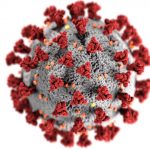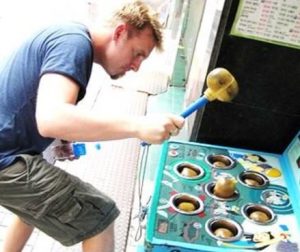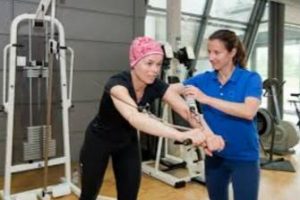January 9th, 2021 by Dr. Val Jones in Uncategorized
4 Comments »
 I used to joke that for all the hardships of being a physician, at least we had job security. Little did I know that a viral illness would put some physicians “on the bread line.”
I used to joke that for all the hardships of being a physician, at least we had job security. Little did I know that a viral illness would put some physicians “on the bread line.”
The COVID-19 pandemic has negatively impacted the physician workforce in both anticipated and unanticpated ways. While stay-at-home orders decrease temporary demand for cosmetic and elective surgical procedures by dermatologists and orthopedic surgeons, inpatient rehabilitation facilities are also feeling the squeeze, though the number of patients who need their services are growing exponentially (due to post-COVID syndromes).
In states of emergency, hospitals at (or over) capacity have the right to commandeer beds from other units within their system. So for example, if there is a unit devoted to the rehabilitation of stroke or car accident victims, the hospital might re-allocate those beds to COVID-19 patients. There is also financial incentive to do so because Medicare pays 20% higher rates to hospitals for each COVID patient that requires admission.
So what happens when the rehab unit turns into a COVID unit? A few things. First, the patients who need inpatient rehabilitation with close physician monitoring are turfed to nursing homes. Fragile stroke patients, those with high risk for neurological or cardiac decompensation, and inpatients with complex medical problems (such as internal bleeding, kidney failure, or infectious diseases) are sent to a lower level of care without suficient oversight by physicians. These patients often crash, get readmitted to the hospital, or in the worst case, decline too quickly to be saved.
Second, the physicians who take care of rehab patients (rehabilitation physicians, also known as physiatrists) hand over care of the COVID patients (in the former rehab unit) to hospitalists, reducing their own workloads substantially while the hospitalists are overwhelmed and at risk for burn out.
Third, hospitals are struggling to cut costs due to the suspension of their lucrative elective surgical pipelines during COVID surges – and put a moratorium on hiring additional physicians who would normally be assisting with growth and expansion efforts in neuromuscular, brain and spinal cord injury rehabilitation.
Finally, in some cases rehab units are experiencing low censuses not because their beds were commandeered for COVID patients, but because elective surgeries have diminished and patients are afraid of coming to the hospital. Many of those with symptoms of heart attacks, strokes, brain injuries, etc. are staying home and “gutting it out” while reversible or treatable injuries and disabilities become permanent. The devastating toll will be difficult to quantify until normal medical surveillance and care resumes.
Meanwhile, physiatrists with outpatient practices and pain management clinics are experiencing a dramatic drop in patient throughput, with telemedicine visits largely inaccessible to the poor and disabled populations they serve. Those outpatient physicians seek to augment their income with part-time inpatient work, and unprecidented numbers are seeking employment through locum tenens agencies. Unfortunately, agencies have scant inpatient jobs to offer for the reasons I discussed above, and competition is fierce among agencies and physicians alike. It’s often the case that 7 or more agencies will contact a physician within hours of a new job posting, and that job will be filled before the physician can respond – and at an hourly rate 20-30% lower than pre-COVID days (based on my personal experience).
These are some of the unexpected underemployment consequences of the COVID pandemic for one sub-specialty group: physiatry. I imagine the forces at play may be similar for my peers in oncology, neurology, or preventive medicine, for example.
One thing is for sure: emergency medicine physicians, internists, and critical care specialists are facing a tsunami of patients while others of us are sitting on the bench, wanting to help but not trained to do so, “sheltering in place” as the non-COVID march of disease and disability continues apace.
June 12th, 2017 by Dr. Val Jones in Health Policy, Uncategorized
No Comments »
 Medical school prepares physicians to prescribe medications for prevention and treatment of disease, but little to no time is spent teaching something just as important: de-prescribing. In our current system of auto-refills, e-prescriptions, and mindless “check box” EMR medication reconciliation, patients may continue taking medications years after their original prescriber intended them to stop. There is no doubt that many Americans are over-medicated, and the problem compounds itself as we age. Although “no-no” lists for Seniors (a tip of the hat to the American Geriatrics Society “Beers List”) have been published and promoted, many elderly Americans are prescribed medicines known to be of likely harm to them.
Medical school prepares physicians to prescribe medications for prevention and treatment of disease, but little to no time is spent teaching something just as important: de-prescribing. In our current system of auto-refills, e-prescriptions, and mindless “check box” EMR medication reconciliation, patients may continue taking medications years after their original prescriber intended them to stop. There is no doubt that many Americans are over-medicated, and the problem compounds itself as we age. Although “no-no” lists for Seniors (a tip of the hat to the American Geriatrics Society “Beers List”) have been published and promoted, many elderly Americans are prescribed medicines known to be of likely harm to them.
You may be surprised to learn that one medical specialty has taken advanced steps to address this problem. Physiatry (also known as Physical Medicine and Rehabilitation or PM&R) is a national leader in pain management education, and is the author and promoter of the majority of continued medical education (CME) courses on reducing opioid prescribing in favor of alternative pain management strategies. But did you also know that most patients who are admitted to an inpatient rehabilitation facility (IRF) are tested on their capability to correctly administer their own medications before they are discharged home?
The MedBox test provides a validated cognitive performance assessment of whether or not an individual can correctly distribute multiple prescription medications into weekly pill boxes as directed on the containers. This is a short video of how the test works, demonstrated by some occupational therapists having a good time with it. In one fell swoop, this test checks vision, reading comprehension, pharmaceutical knowledge, manual dexterity, attention, and short term memory.
This test is very helpful in picking up potential misunderstandings in how prescription meds are to be taken, and identifying cognitive deficits that might preclude accurate self-administration of prescription meds at home. One of our main goals in rehab is to make sure that patients have the skills, assistance, and equipment necessary to thrive at home, so that they can remain hospital-free for as long as possible. To that end, we feel strongly that limiting medications to those only truly necessary, as well as making sure that patients can demonstrate safe-use of their medications (or have a caregiver who can do this for them), can reduce hospital readmission rates, falls, unwanted drug side-effects and accidental drug-drug interactions.
In addition to MedBox testing, physiatrists invite hospital pharmacists to join their weekly patient team conferences. While we discuss patient progress in physical, occupational, and speech therapies, we also review nursing assessments of medication self-administration competency, and ask our pharmacist(s) which medications can potentially be stopped or decreased that week. Rehab physicians (familiar with patient health status, goals, and current complaints) and pharmacists together come up with stop dates and taper regimens at these weekly meetings.
Part of the reason why inpatient rehabilitation has been so successful at reducing hospital readmission rates, in my view, is that we are committed to pharmaceutical whack-a-mole. “Test-driving” patient competency at medication self-administration, in the setting of responsible de-prescribing in a monitored clinical environment, is a highly valuable (though sadly under-reported) benefit of rehabilitation medicine. I hope that my medical and surgical peers will join us physiatrists in combating some of the patient harms that are passively occurring in our healthcare system designed to add, but not subtract, diagnoses and treatments.
April 5th, 2017 by Dr. Val Jones in Health Tips, Opinion
1 Comment »
This blog post first appeared at: Curious Dr. George
 Rehabilitation medicine is one of the best-kept secrets in healthcare. Although the specialty is as old as America’s Civil War, few people are familiar with its history and purpose. Born out of compassion for wounded soldiers in desperate need of societal re-entry and meaningful employment, “physical reconstruction” programs were developed to provide everything from adaptive equipment to family training, labor alternatives and psychological support for veterans.
Rehabilitation medicine is one of the best-kept secrets in healthcare. Although the specialty is as old as America’s Civil War, few people are familiar with its history and purpose. Born out of compassion for wounded soldiers in desperate need of societal re-entry and meaningful employment, “physical reconstruction” programs were developed to provide everything from adaptive equipment to family training, labor alternatives and psychological support for veterans.
Physical medicine and rehabilitation (PM&R) then expanded to meet the needs of those injured in World Wars I & II, followed closely by children disabled by the polio epidemic. In time, people recognized that a broad swath of diseases and traumatic injuries required focused medical and physical therapy to achieve optimal long term function. Today, cancer patients frequently benefit from comprehensive rehabilitation as they recover from the effects of chemo (neuropathy, weakness, and cognitive impairments), radiation (scarring and range of motion limitations), surgery (flaps, plastics procedures, tumor resection, amputations), and brain injuries (edema, debulking, gamma knife and neurosurgery).
Rehabilitation is a phase of recovery occurring after any major life-changing medical or surgical event. Our bodies are designed to regenerate and repair, though optimizing this process takes skilled guidance. PM&R physicians (also known as physiatrists) are trained to use physical modalities (stretching, strengthening, heat, cold, etc.) to mechanically enhance healing. They prescribe medications to manage pain, spasticity, nerve injury, and cognitive impairments, while also leveraging the power of physical therapy to increase cardiopulmonary fitness, muscle strength and flexibility. PM&R physicians are also experts in neurologic injury, and can adapt exercises to coax spinal cord, brain and peripheral nerve injuries to construct new pathways for movement and repair.
Inpatient rehab’s prime directive is to get patients back home. To succeed at home, patients need to be able to function as independently as possible, using trained assistants for managing the activities that cannot be performed without help. Admission to a rehab hospital or unit offers the patient home practice opportunities – with simulated challenges that can include everything from terrain parks, test kitchens, medication management trials, driving simulators, balance tests, electric wheelchairs and even exoskeletons that allow paralyzed patients to walk again. It is like a robotic Disney World, with endless aquatic and equipment possibilities for restoring movement and independence.
When I discuss admission to inpatient rehab with my cancer patients, I ask them about their goals, motivation, and energy levels. Timing of rehab is important, because it must dovetail with treatment, so that the physical exertion strengthens, not saps, the patient. Often times when a person is newly diagnosed with cancer, they want “everything done” – intensive chemo/radiation/surgery as well as rehab/exercise. But staggering these interventions can be more effective.
In other cases when care is palliative, learning new skills and being fitted with battery or electric-powered equipment can mean the difference between living at home or in an assisted environment. Some successful cancer patients come to inpatient rehab to practice managing their activities of daily living with varied amounts of assistance, preparing for increased needs as time goes on so they can enjoy being at home for as long as possible.
For the physiatrist, cancer is a cause of impairments that can be overcome with creativity and practice, no matter the long-term prognosis. Adaptive equipment, physical exercise, and cognitive retraining may be applied intensively (3 hours a day in the inpatient setting), or at a slower outpatient pace, depending on individual need. Rehab physicians desire to support and sustain patient function at the highest level, and “add life to years.” As such, rehabilitation should be considered an integral part of successful cancer care and management.
 I used to joke that for all the hardships of being a physician, at least we had job security. Little did I know that a viral illness would put some physicians “on the bread line.”
I used to joke that for all the hardships of being a physician, at least we had job security. Little did I know that a viral illness would put some physicians “on the bread line.”

 Medical school prepares physicians to prescribe medications for prevention and treatment of disease, but little to no time is spent teaching something just as important: de-prescribing. In our current system of auto-refills, e-prescriptions, and mindless “check box” EMR medication reconciliation, patients may continue taking medications
Medical school prepares physicians to prescribe medications for prevention and treatment of disease, but little to no time is spent teaching something just as important: de-prescribing. In our current system of auto-refills, e-prescriptions, and mindless “check box” EMR medication reconciliation, patients may continue taking medications  Rehabilitation medicine is one of the best-kept secrets in healthcare. Although the specialty is as old as America’s Civil War, few people are familiar with its history and purpose. Born out of compassion for wounded soldiers in desperate need of societal re-entry and meaningful employment, “physical reconstruction” programs were developed to provide everything from adaptive equipment to family training, labor alternatives and psychological support for veterans.
Rehabilitation medicine is one of the best-kept secrets in healthcare. Although the specialty is as old as America’s Civil War, few people are familiar with its history and purpose. Born out of compassion for wounded soldiers in desperate need of societal re-entry and meaningful employment, “physical reconstruction” programs were developed to provide everything from adaptive equipment to family training, labor alternatives and psychological support for veterans.







